In my work I am led by my urge to create and by my fantasy. By feelings, ambience, rhythms and lines. My vast collection of textile materials and my good, old sewing machine do the rest. Just for a change I would like to introduce myself this time with an anthology of fragments from several opening speeches:
 2010 Carel Davidson, De Tweede Uitleg,
2010 Carel Davidson, De Tweede Uitleg,
Amsterdam 26 February
Saskia has converted the man-made material Tyvek into a Synthetic material with a capital S. Like all plastics, one can reshape polyethylene materials by heating. However, as temperature cannot constantly fully be controlled, you do not always master the matter, but the matter may run of with you. It is admirable that Saskia allows, Tyvek to take her now and then by surprise. When Tyvek has not just been heated, but even here and there been burned into black-greyish substance, her works reminds me of paintings by Anselm Kiefer.
 Within my profession, I am supposed to know things rather than to judge them. Yet, as an art loving material scientist, I may posit that these peintisseries demonstrate, that Saskia creates extraordinary works of Art with an admirable command of the materials. For herself, she may go away with her device "guidés par le hasard ", but this work cannot just be a result of simply chance. Without doubt, it is her great talent that enables her to compose these original and marvellous peintisseries out of such a rich
variety of components.
Within my profession, I am supposed to know things rather than to judge them. Yet, as an art loving material scientist, I may posit that these peintisseries demonstrate, that Saskia creates extraordinary works of Art with an admirable command of the materials. For herself, she may go away with her device "guidés par le hasard ", but this work cannot just be a result of simply chance. Without doubt, it is her great talent that enables her to compose these original and marvellous peintisseries out of such a rich
variety of components.
 2009 Opening speach Bonne ten Kate, Amstelkerk:
2009 Opening speach Bonne ten Kate, Amstelkerk:
Being asked to characterize the pictorial landscape of Saskia's art., I would be inclined to emphasize the organic origins, such as sprouting, growing, flowering, blossoming, just to underline the vegetative force of her peintisseries. I experience intuitively an organic vitality, while observing the layered surface of her art pieces. I have to say that this is quite an exceptional experience for me while being confronted with art.Afer a long period of merely drawing Saskia started in 1970 to produce landscapes by sewing textile on canvases. Not exactly by way of well-known quilts or patchworks, but a very personal, special and creative variety of such.
Early works show excellent draughtsmanship and by and large an uncommon sense of bold and free composition combined with a moderate coloration. Initially the sewing was done by hand, until she discovered the free machine embroidery.
Hereafter se developed the typical Saskia-style, definable as "painting with textiles."
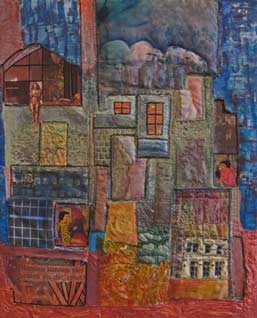 In the meantime she extended and enriched her technique by the application of tyvek, fibrefill and acrylic paint. These technical additions cause, especially in changing light conditions, relief-like skin structures with playful effects, Heating or ironing tyvek results in shrinking, melting, bubbling, swelling and wrinkling the material.
In the meantime she extended and enriched her technique by the application of tyvek, fibrefill and acrylic paint. These technical additions cause, especially in changing light conditions, relief-like skin structures with playful effects, Heating or ironing tyvek results in shrinking, melting, bubbling, swelling and wrinkling the material.
Next step in extending her pictographical language is applying photographs and words in Hebrew, Japanese or other languages..
Just like the cubist painters, a century ago, in their paper-collage canvases, Saskia uses textile fragments and other additives merely as means of expression. Like painters do with oil paint, she transforms her material, reshaping it into landscapes, cities, houses, trees, flowers etcetera.
There are, of course, more ways to look at art paintings in general, but I feel a certain affinity with the painter Pierre Bonnard. In my view she is sharing a similar kind of sensibility and she is, in her own way, a colourist too. Most of Saskia's work is sheer music to me – as comforting as baroque music with its polyphonic structure. One might find, so to speak, transcendental dynamics as the abstract counterpoint of a fugue.
And all these inventive, playful fantasies in the glowing colours of stained-glass windows, in the swiveling rhythms of Vincent van Gogh and Chaim Soutine.(Excerpts of opening speech- exhibition Amstelkerk -2 July 2009)
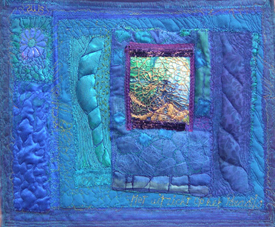 2005 Ronny Naftaniël, Middelburg Synagogue:
2005 Ronny Naftaniël, Middelburg Synagogue:
Saskia didn't inherit her creativity from strangers. Both of her parents were artists in Bergen, North Holland. Her father, Rein Snapper was a painter, designer and graphic artist. Her mother Mies Bloch illustrated childrens' books and drew many portraits. She is also famous for her Margriet Cross Stitch book, published in the fifties. With such a background it's not surprising that Saskia, after studying French, choose to become a professional artist. Even her specialisation, textiles, seems to be pre-ordained.
Saskia is a very original artist. Her work is surprisingly innovative. This is mainly due to her use of materials.
 At the opening of Saskia's exhibition in the Van der Togt Museum in Amstelveen, Frans Megens described Saskia as a woman with an almost inborn modesty. At the same time - he said - he had rarely met someone in the last 25 years, who dared to use her materials with such courage and daring. He couldn't have said it better; Saskia's peintisseries are a symbiosis of craftsmanship, understanding of her materials, inventiveness, sense of colour, both the Jewish and parental tradition and daring. During the last few years Saskia has combined different sorts of fabric with painted tyvek.
At the opening of Saskia's exhibition in the Van der Togt Museum in Amstelveen, Frans Megens described Saskia as a woman with an almost inborn modesty. At the same time - he said - he had rarely met someone in the last 25 years, who dared to use her materials with such courage and daring. He couldn't have said it better; Saskia's peintisseries are a symbiosis of craftsmanship, understanding of her materials, inventiveness, sense of colour, both the Jewish and parental tradition and daring. During the last few years Saskia has combined different sorts of fabric with painted tyvek.
This sandwich is then embroidered with the sewing machine and manipulated by heat. She creatively transforms those fabrics into jewels of artistic expression. Harmonising colours with a warm Jewish feeling and using joyfully sounding titles such as: 'A view of Paradise', 'Less is not More' and 'Let's drink under the Sun'.
Saskia calls her work peintisseries, a fusion of peinture (painting) and tapisserie (tapestry). She has a painterly approach to textiles.
Since 1976 her peintisseries have been exhibited in Germany, England, Italy, Greece and Japan; and of course the Netherlands.
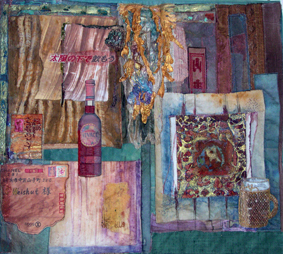 In 1991 she won the first prize in a competition of Textile Plus.
In 1991 she won the first prize in a competition of Textile Plus.
In 2003 her 3D creation 'Close Harmony' was selected for the exhibition 'Freedom of Stitch', by the Royal School of Needlework, and shown at the Knitting and Stitching Show in London. In 2005 the portrait of her five sons, made by Saskia, also hung there, as part of the Pfaff Embroidery Challenge.
From June 2006 the quilt 'Passé Décomposé ' was chosen as part of the European Art Quilt lV travelling exhibition.
Not only Saskia's Jewish ritual art, but also her other expressions in textiles, are exciting, inventive, colorful and optimistic. They are a reflection of a people who have always cherished hope. One of her major pieces is a wedding canopy (chupah), which she made for the permanent collection 'Tradition', at the Jewish museum in Berlin (Libeskind).
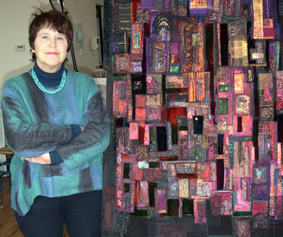 2005 Rita Kohnstamm, Achter de Zuilen, Bloemendaal:
2005 Rita Kohnstamm, Achter de Zuilen, Bloemendaal:Saskia's mixed-media paintings, peintisseries, are often floral. Not in the literal sense, but more an impressionistic rendering of a luxurious flowering meadow, in which the colours blend and the sunlight sparkles.
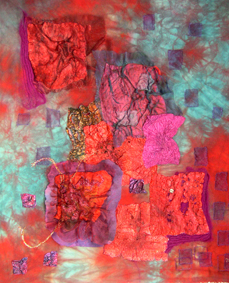 These qualities are characteristic of much of Saskia's work. There is an invitation to look further to something in the background. A rapport between the fore- and background.
These qualities are characteristic of much of Saskia's work. There is an invitation to look further to something in the background. A rapport between the fore- and background. Just as in a detail of 'Intimacy', where the whole image seems to have been created to lead the eye to that special star. Her creativity and imagination create a new reality. Or, like Anna Tilro, the art critic from the NRC Handelblad once powerfully described: "the ability of art to depict something of which no image yet exists". This is exactly what Saskia does.
2005 Joyce Smook-Noach, Dijksynagoge, Sliedrecht:
Saskia uses a unique technique, in which she manipulates shape, colour and materials into compositions,
which evoke the feeling of warm, even balanced, sometimes urban landscapes with a philosophical or religious connotation.
Nothing is coincidental, everything is intentional.


2005 Jan Scheffers, Galerie De Osseberg, Grijpskerke:
In every personal religion we seek our relationship with the truth, with goodness and with beauty. What is the truth for me and what is false? How can I create beauty and how can I be nourished by it?
Religion is also expression, for beauty cannot be without images, without language or without music. We need to observe. So every work of art has spiritual content. It creates links, it communicates and breathes life. The artist wants her work to speak and so the artist remains silent.

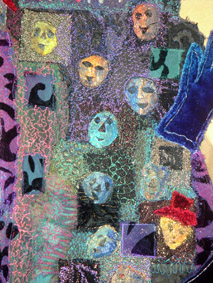
 2003 Frans Megens, Museum Jan van der Togt:
2003 Frans Megens, Museum Jan van der Togt:Saskia's autonomous works are for me small symphonies of colour. She composes colours, materials and shapes in a particular way in order to tell her story.
She allows us to share her imaginary world. To absorb this feast of colours, makes us joyful, invites us to contemplate and allows us to fantasize further.
She transforms the materials she uses into a new medium. We know that she uses textiles, but she paints and sculpts in such a way that they become something totally new. Here we are dealing with a self-made professional woman of a kind I have rarely met in the Netherlands.
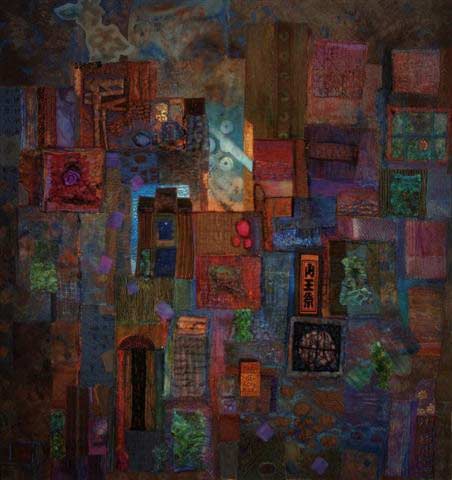 2000 Loan Oei, De Gang, Haarlem:
2000 Loan Oei, De Gang, Haarlem:
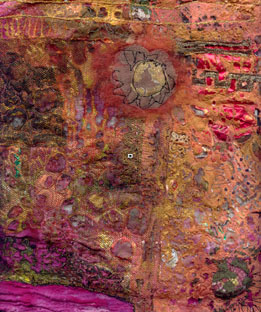 Saskia is an example of an artist who is driven to translate her memories and fascination for natural and urban landscape into a new palpable reality.
Saskia is an example of an artist who is driven to translate her memories and fascination for natural and urban landscape into a new palpable reality.
She once confessed that creating a landscape of fabrics - seeing mountains and hills rise before her eyes - in the colours and materials she has chosen herself -gives her literally a divine sense of creativity - as if you may be 'god' for a moment.
In this way she manifests the excitement felt when she is creating. Dieu créa la femme et Saskia créa la peintisserie……..
1999 Dery Timmer, Het Oude Raadhuis, Warmond:
Saskia calls her work 'peintisseries' and that is exactly what they are.
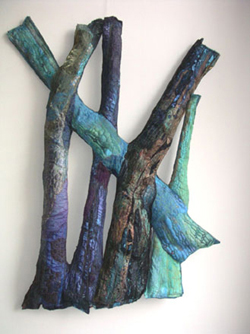

The early beginning of her peintisserie-work was more than 25 years ago in Epse, near Deventer - the town famous for it's 'pâtisseries' (cakes).
Those who have followed her work over the years know that she has slowly reached a state of perfection.
In this gallery you can see only her most recent work, but believe me, her work has become more beautiful, warmer, intenser and more touching. And more ingenious.
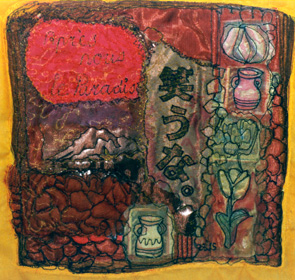
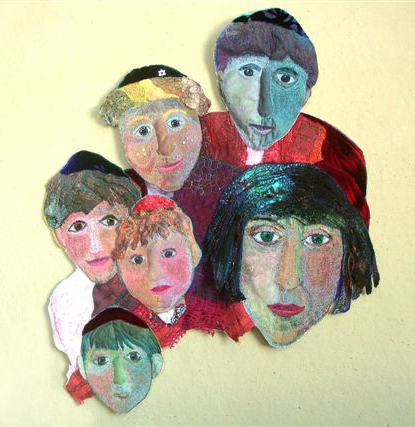
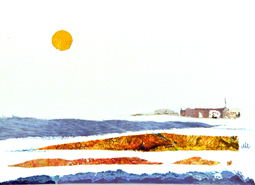 It is written that Bezalel and Oholiav were filled with the spirit of God, that is, with wisdom, insight and knowledge. What is the difference between these three concepts? Rashi, one of the most important Jewish commentators, explains this as the following way:
It is written that Bezalel and Oholiav were filled with the spirit of God, that is, with wisdom, insight and knowledge. What is the difference between these three concepts? Rashi, one of the most important Jewish commentators, explains this as the following way: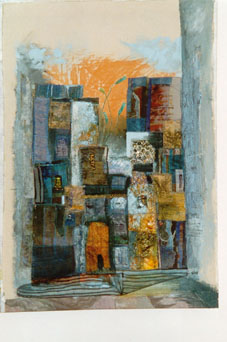 Gochma is wisdom, things that you learn and hear from others.
Gochma is wisdom, things that you learn and hear from others.Tevuna is insight, applying what you have learnt with your own insight.
Da'at is knowledge. Not just knowledge as such, but that obtained by divine inspiration, by contact (almost physical) with the divine.
Saskia is imbued with these three qualities.
Wisdom is the learning and mastering of different techniques.
Insight is the choosing and application of techniques in a personal way.
As for divine inspiration, she hasn't experienced this especially in a work such as 'Wailing Wall', but more in works depicting nature; a desert, a town extending up to the heavens, brightly coloured flora (entitled Paradise), the moon above the mountains…
In 1970 Saskia discovered the wall hanging. This was a most peculiar outlet for her artistic tendencies. As a child she had developed a strong aversion to needlework. Her teacher predicted early on that Saskia would never become a needlewoman. What drew Saskia then to the wall-hanging?
We don't really know.
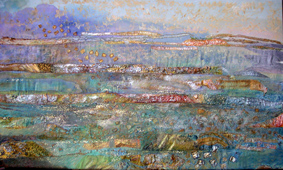 But as diligently as an ant she emerged herself in it………….
But as diligently as an ant she emerged herself in it………….What was the maker of these peintisseries striving for?
To distract us from the daily drudgery, from banality. Especially to distract us from the misery which reaches us everyday in unstoppable waves via newspapers, radio and television.
To provide us with the beauty that empowers us to arm ourselves against the world around us.
My suggestion would be to hang your eventual purchases in front of the television, or in any case nearby, in order to benefit from it's healing powers…
translation by Cherilyn Martin